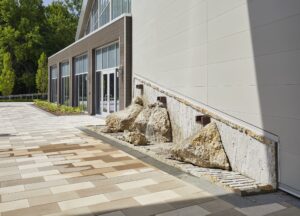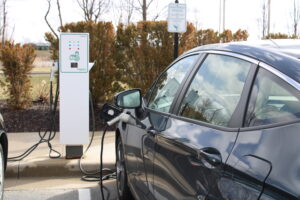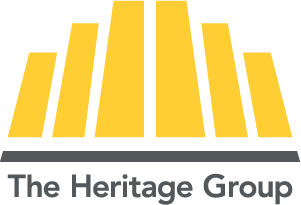If you’ve ever been to The Center on the northwest side of Indianapolis, you know what an impressive campus it is. The Center serves as The Heritage Group’s hub of connection, collaboration and innovation.
Both LEED and SITES certified, The Center campus is also a beacon of sustainability.

Boulders and stone, gathered from Indiana quarries, were incorporated into the building’s design.
Boulders, stone panels and aggregate came from our own Indiana quarries, native plants attract pollinators and provide habitat for birds and other creatures, solar panels power lighting on our entrance signage and rainwater gathered in ponds is used for irrigation. The Heritage Group thoughtfully designed this space to make the smallest environmental impact, and we continue on our sustainability journey, always looking to improve. It’s the right thing to do for our people, planet and communities.
Zero Waste to Landfill
In a concerted effort to reduce our waste, and in partnership with experts from our operating company Envita Solutions, we’ve spent the last year re-evaluating best practices, taking very detailed measurements and making improvements with this goal in mind: reaching Zero Waste to Landfill. Company leadership, employees and vendors all played a part in this win through these steps:
- No more single-use plastics. Employees often carry reusable water bottles or compostable cups into meetings.
- Compost food waste. Green with Indy takes our compostable products and turns it into compost for community projects.
- Like-minded caterers. Meals are served using compostable or recyclable plates, napkins and flatware.
- Construction “clean fill.” Because they won’t leach into the ground, materials from the lab such as asphalt mix and aggregate can be used as a clean fill material.
- Waste to energy. Through our waste hauler, our reduced amount of waste is repurposed as fuel.
“Thanks to this teamwork, we’re now diverting 100% of our waste from the landfill,” said Anne Smith, THG’s Senior Director of Sustainability. “Plus, these steps also helped us earn six more points in our LEED recertification, bumping us up to the Silver level. We couldn’t be happier with this outcome!”
LEED Recertification: Silver Level

Onsite charging stations for electric vehicles.
When you walk into a LEED certified building, you see a badge proudly displayed that announces that status. This badge is hard earned and indicates that sustainability is a top priority for the building owners and occupants.
It’s not a one-and-done thing: LEED recertification happens every three years, so it’s an ongoing effort according to Todd Dobbs, Facilities Manager for THG, who led our most recent recertification. “Being recertified shows that we aren’t just putting a plaque on the wall. We’re continuing to live and work sustainably.”
The recertification work was boosted by an energy audit and recommendations on how to reduce our energy consumption. Following those recommendations, The Center invested in monitoring systems that evaluate energy needs and adjust lighting, temperature and ventilation controls to meet those needs without waste.
For example: In our lab, fans in the ventilation hoods were running at 100% all day, every day. Now, with occupancy sensors installed, controls dial fans back to a minimum level after 30 minutes of no occupancy. That means all night, all weekend, we’re saving energy.
Although we used LED bulbs in many areas of the building, we were able to convert 1,000+ bulbs to LED versions. Moves like this resulted in huge improvements in efficiency, reducing our reduced electrical consumption by 30% and natural gas by 40%.
Besides energy consumption, LEED includes measurements in other areas too:
- There’s little room for improvement there, with motion-activated faucets and low-flow toilet tanks already in place.
- We asked employees who work in The Center to share information about their commutes and what vehicles they drive. Thanks in part to the EV charging stations in the lot, we’ve grown from two employees with electric vehicles in 2017 to approximately 10 this year.
- Human Experience. We also asked employees to share their impressions about their work environment, amount of daylight and outdoor spaces. The response was overwhelmingly positive.
“Our long-term goal is to continue our work in this area — we still have gains to make,” said Todd. “Maybe someday we’ll even hit Gold!”
Did you know?
LEED-certified buildings save money, improve efficiency, lower carbon emissions and create healthier places for people. They are critical to addressing climate change, enhancing resilience and supporting more equitable communities.
SITES-certified projects help reduce water demand, filter and reduce stormwater runoff, enhance biodiversity, provide pollinator and wildlife habitat, reduce energy consumption, improve air quality, improve human health, increase outdoor recreation opportunities and much more.
